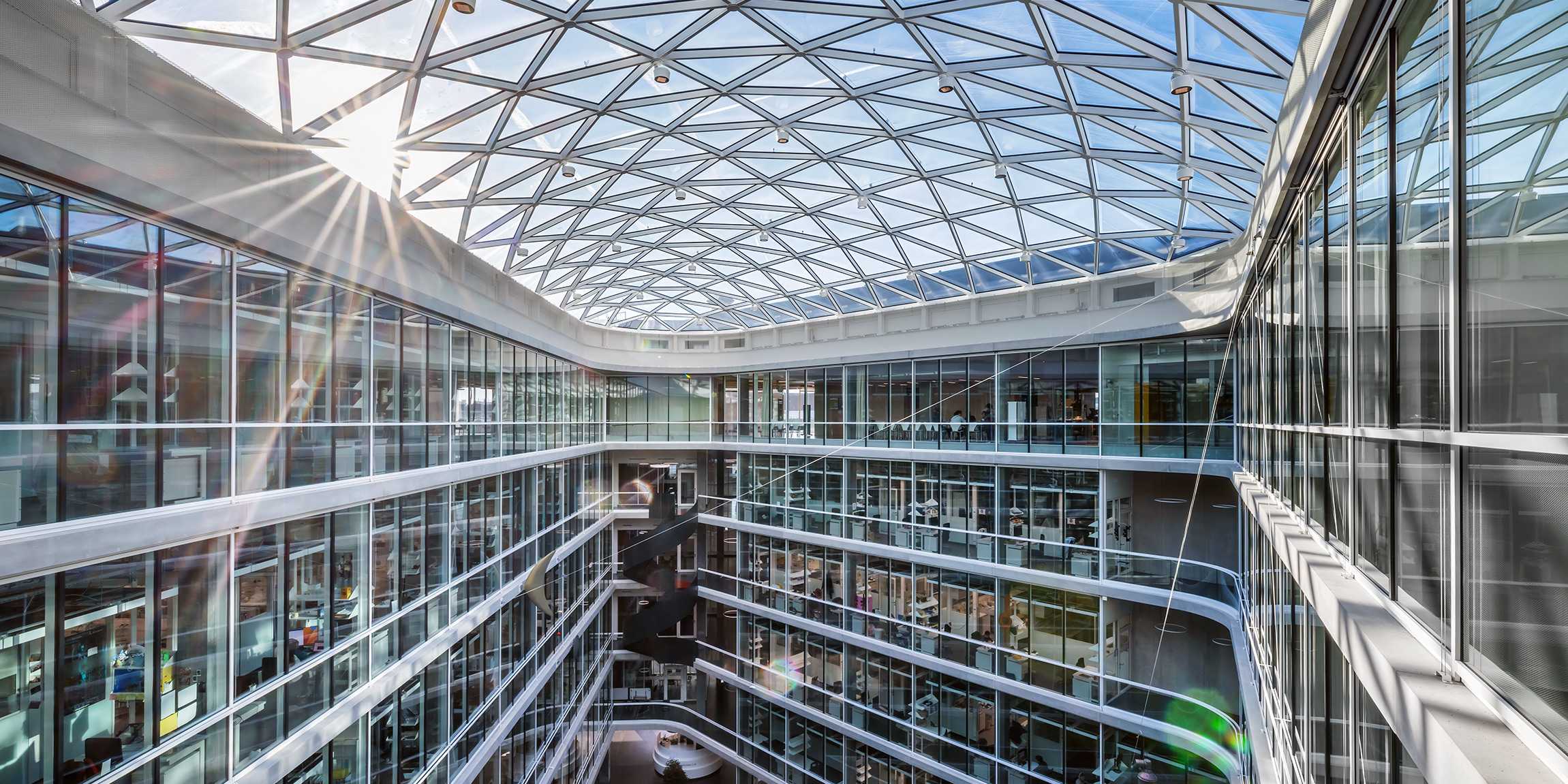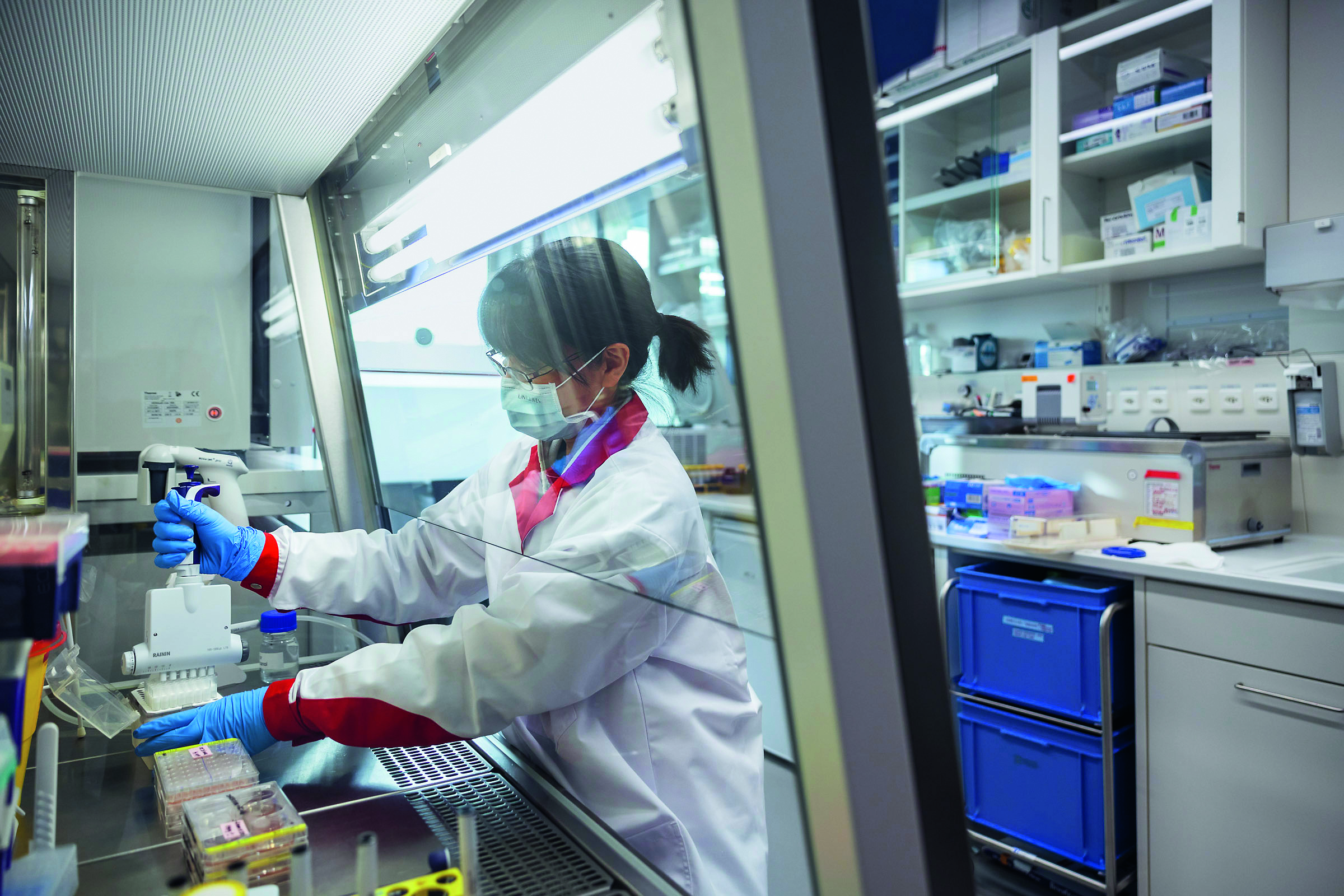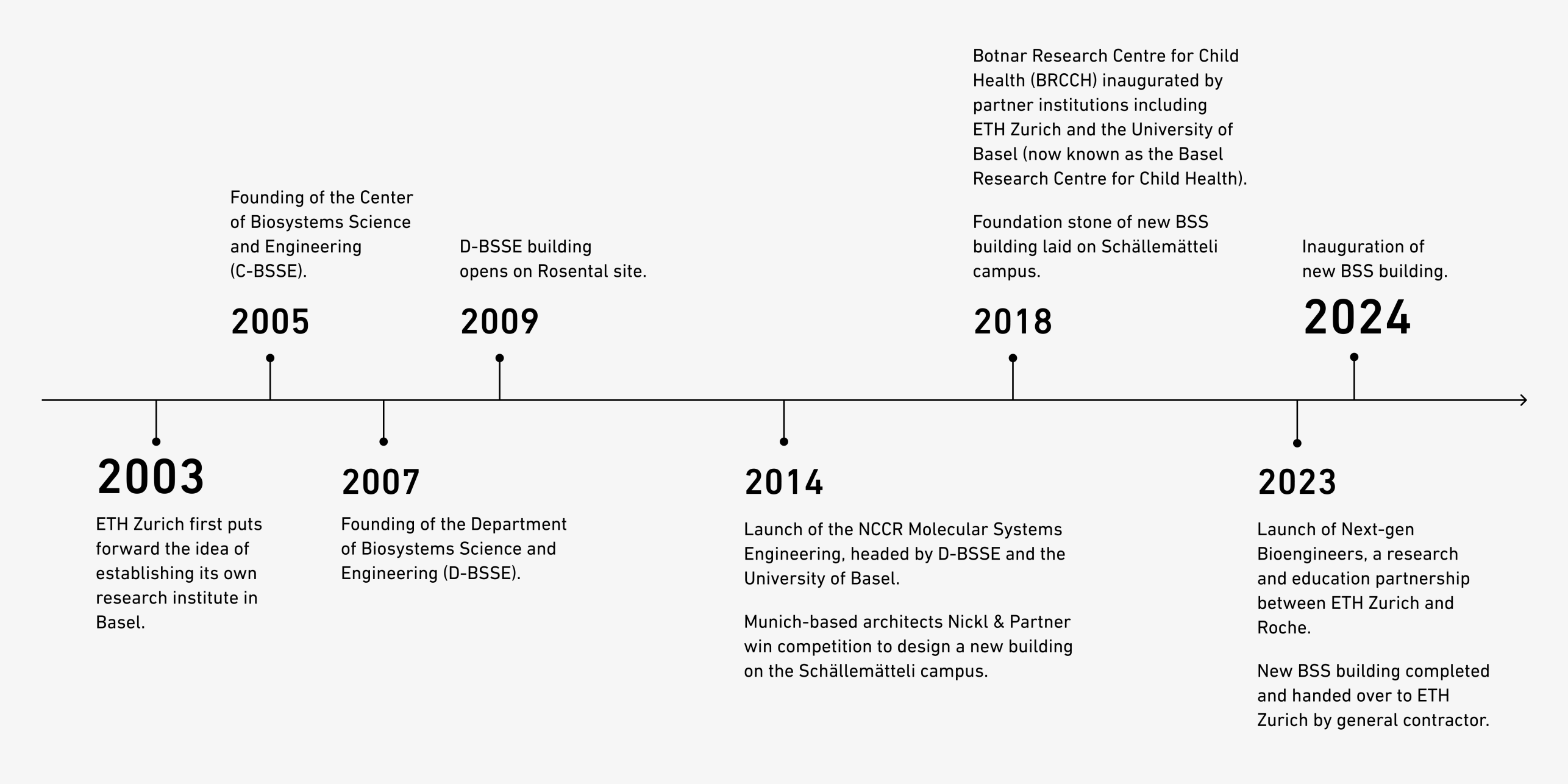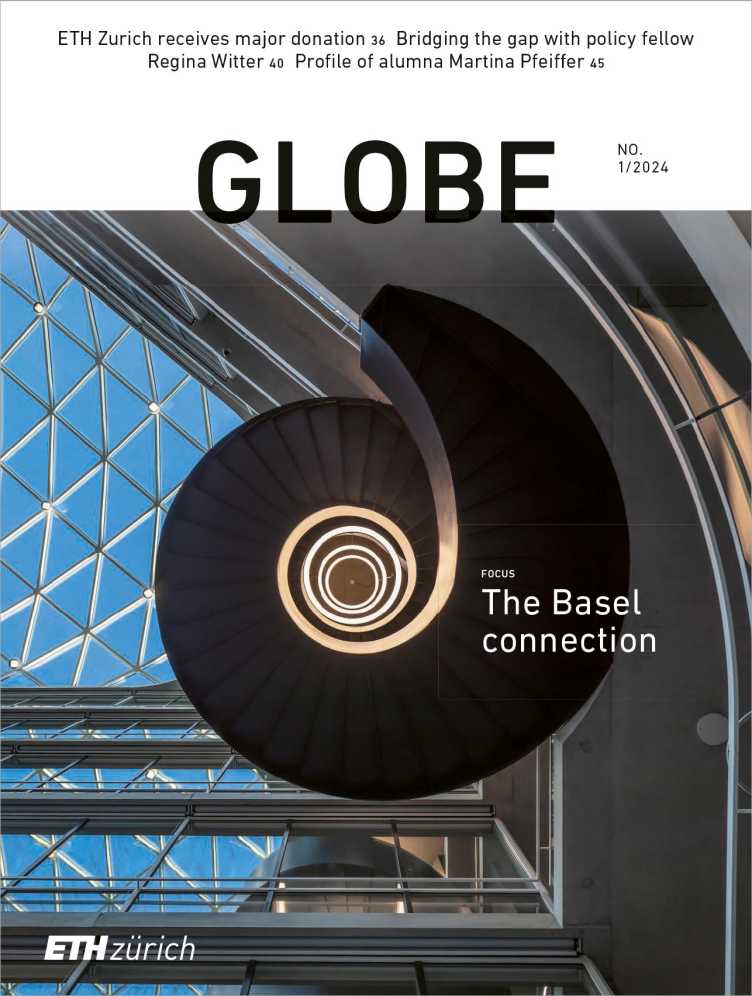
Designed for bold visions
The idea of ETH Zurich establishing a Department of Biosystems in Basel once seemed unachievable. Today, the department occupies a new building where the dividing lines between biology, computer science and engineering are blurred – and researchers increasingly focus on medical applications
An impressive sight awaits first-time visitors to the new BSS building. Immediately beyond the reception area, they plunge into a surprisingly bright and airy space, a towering atrium flooded with light and topped by a transparent glass roof. At the end of this huge concourse, a helical staircase winds its way up to the floors above. The impression is one of countless connecting lines, a deliberate ploy on the part of the architects to foster communication and interaction between research groups. Right now, the atrium is bustling with backpack-toting students, some descending the curving path to the welcoming bistro. Researchers waiting for the lift pause for a quick chat before heading up to their workspaces.
“Right from the planning stage, our goal was to create a building in which all the various components encourage interaction and scientific exchange.”Renato Paro
Standing in the centre of the atrium are Renato Paro and Sven Panke. Paro, now an emeritus professor of molecular biology, is still visibly taken by the concept. “When I walk through the BSS building and see all these offices, labs and joint research platforms, it makes all the time and effort we invested in creating our department seem worthwhile,” he says. Appointed as the inaugural director of the fledgling Center of Biosystems Science and Engineering (C-BSSE) in 2006, Paro went on to become one of the driving forces behind the creation of the ETH Department of Biosystems Science and Engineering (D-BSSE). “For me, this building represents the culmination of an amazing journey,” he says.
“Right from the planning stage, our goal was to create a building in which all the various components encourage interaction and scientific exchange,” he continues. Panke, who takes over the reins of the department this year, nods in agreement, noting how all the professors have steadily built upon this original concept: “We decided that each floor should have a mix of research groups rather than organising them by subject area."

Interdisciplinarity in action
The department is divided into three main areas – experimental biology, computational theoretical biology and bioengineering – with each floor of the building hosting a mix of experimental biologists, bioinformaticians and bioengineers working in adjacent offices and laboratories. “We saw early on that one of the main benefits of D-BSSE was getting all three of these research areas under one umbrella to encourage the groups to communicate with each other. And now that we’re all under the same roof, it’s even easier to mingle and interact,” says Panke. “This is interdisciplinarity in action – and it’s attracting researchers from all over the world.” D-BSSE currently employs researchers from 42 different countries.
Panke’s own bioprocess laboratory, for example, is on the same floor as the group led by Niko Beerenwinkel. Both are typical of the special mission of the department, which seeks to combine basic research in life science with a mathematical and computer science approach while also incorporating a technological, engineering component. Panke specialises in miniaturisation techniques for bioprocess engineering that can be used to discover and synthetically control enhanced cell variants. Beerenwinkel, meanwhile, unites mathematics, computer science and artificial intelligence with biology and medicine. Applications of his computational methods include the ability to characterise and describe viral illnesses at a molecular level. His models proved a highly useful tool during the coronavirus pandemic. Together with Tanja Stadler, Professor of Computational Evolution at D-BSSE and president of the Swiss Science Advisory Panel for COVID-19, Beerenwinkel played an important role in efforts to detect new variants of the coronavirus and to track their evolution and spread.
“Two of the pioneering areas of work at our department in Basel are bioengineering and computational data science.”Sven Panke
The work of D-BSSE researchers builds on the foundation of systems biology. Its aim is to generate a holistic understanding of how cells, organs and organisms function and of the temporal and biochemical processes that keep them alive. To study how they work, researchers typically employ large data sets, generated by high-throughput technologies such as DNA sequencers, as well as mathematical models and computer simulations. Systems biology also plays a role in the second strand of D-BSSE’s research work, synthetic biology – the main goal of which is to produce cells, organoids and microorganisms with new properties that are not found in nature, many of which offer potential medical benefits.
Blazing a trail in Basel
D-BSSE’s work in the field of bioengineering, which uses DNA to regulate cells and organisms, has an equally practical focus. Concrete outputs of this research include vaccines and antibodies for synthetic immunology, as well as cellular implants that can help combat metabolic disorders, and miniaturised platforms such as lab-on-chip technologies. “Two of the pioneering areas of work at our department in Basel are bioengineering and computational data science,” says Panke, who has been part of D-BSSE since 2009. “It is only logical that we also show our students the benefits of bringing these two components together.”
The idea of establishing an ETH bioscience research institute in Basel began to germinate in the year 2000. Looking back, it is clear just how bold this vision was. Equally astute was ETH Zurich’s decision to turn D-BSSE into a separate department in Basel in 2007 and to provide it with secure long-term funding. Of course, D-BSSE’s evolution wasn’t always plain sailing: in 2003, for example, the Neue Zürcher Zeitung declared that the plan to establish an ETH outpost in Basel had run into difficulties. The newspaper expressed astonishment at ETH Zurich’s plans to create a fully fledged department of bioengineering or biomedical engineering in Basel: “Such a grandiose idea seems almost unachievable.” Yet their scepticism proved unfounded.

The next stage in D-BSSE’s development came when it moved from the Rosental site into the BSS building on the Schällemätteli Life Sciences Campus. As systems biology and synthetic biology gain traction and knowledge in these areas continues to advance, more and more emphasis is now being placed on translating the findings of basic research into medical applications. “Today, systems biology often has such a profound understanding of how a cell works that it can provide most information for controlling key processes within the cell,” says Paro. “By harnessing this expertise, synthetic biologists can then reprogramme a cell to perform a new task. In future, these reprogrammed cells may well be used for therapeutic purposes.”
Translational research
But such cells can only be used in patients if they are produced in compliance with the strictest pharmacological standards. Prior to its move, D-BSSE lacked the infrastructure required for this purpose – but the new BSS building came equipped with a GMP facility (see box). “This means we can now progress to the translational phase of our research,” says Paro. “Working under GMP conditions, we can enhance reprogrammed cells and purify them so that they can be used in clinical trials.”
Infrastructure for medical applications
The new Good Manufacturing Practice (GMP) facility is run by ETH Zurich in collaboration with the University of Basel and University Hospital Basel. It provides researchers with a strictly controlled, ultraclean environment for producing gene, cell and tissue-therapy products that comply with regulatory requirements for human clinical trials.
This evolution toward translational research has also been eased by the D-BSSE’s new location on the Schällemätteli Life Sciences Campus, which lies in the immediate vicinity of the University Hospital Basel, the University Children’s Hospital Basel and the University of Basel’s Biozentrum. Basel University’s Department of Biomedicine and the Basel Research Centre for Child Health are also planning to build new premises nearby. This proximity is likely to further accelerate the translation of biological research into medical applications.
About
Sven Panke is Professor of Bioprocess Engineering at the Department of Biosystems Science and Engineering.
Renato Paro is Professor Emeritus of Molecular Biology at the Department of Biosystems Science and Engineering.
Globe The Basel connection

This text appeared in the 24/01 issue of the ETH magazine Globe.
DownloadRead whole issue (PDF, 3.5 MB)
